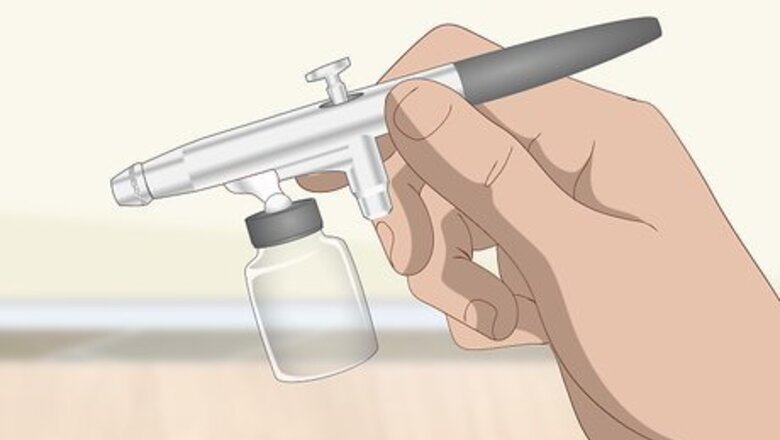
views
Using an Airbrush Kit

Purchase a single action airbrush kit if you’re a beginner. If nail airbrushing is new for you, consider buying a single action airbrush kit. It is easy to operate, as all you need to do to is press a button that will release your paint. They are excellent starter airbrushes because they provide great paint coverage on the nail. Plus, they are relatively cheap compared to other airbrush types. Single action airbrush kits do not offer great precision, so if you’re creating a nail look with intricate details, this might not be the right kit for you.
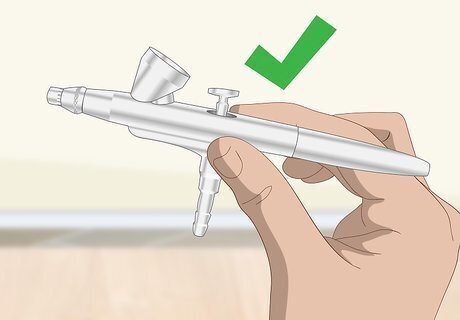
Buy a dual action airbrush kit for precision and extensive detailing. Dual action airbrush kits are typically for the more experienced nail technician. They allow you to fully control the air pressure and paint flow during application. Dual action kits are great if you need to paint with precise lines and fine details. Many airbrushes serve many functions. They can be used for cosmetics, painting, tattooing, and tanning. Make sure the airbrush kit you purchase is compatible with nail crafting.

Connect your airbrush to the air compressor with the air hose. Included in any airbrush set are an airbrush stylus, air hose, and air compressor. The air hose is a long, durable pipe that connects the airbrush stylus to the air compressor machine. It pushes air from the compressor, which ultimately shoots to the stylus and mixes with the paint. Each end of the hose has a metal screw-on connector. You’ll use your thumb and index finger to twist the screws. Attach one end of the hose to the compressor, and then the do the same thing on the other side to attach it to the gun. Make sure you screw on each end of the hose very tight before starting the machine.
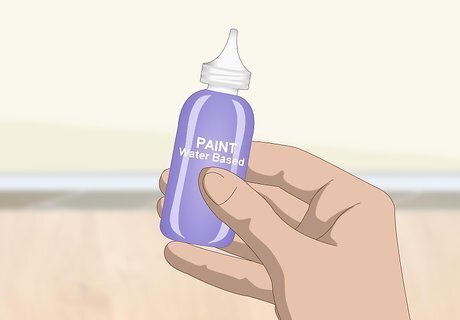
Select a water-based paint. Airbrush kits must be used with water-based paint. Regular nail polish is too thick and will not flow well through the airbrush gun. Some airbrush kits made especially for nails may already include some airbrush nail paint. Others will not, so you’ll have to purchase your own paint separately online or at a beauty supply store. Don’t try to use regular nail polish in your airbrush unless the directions specify that it’s okay to do so. Using the wrong kind of paint, even with paint thinner mixed in, could clog up your airbrush gun or create a lumpy and uneven paint job.
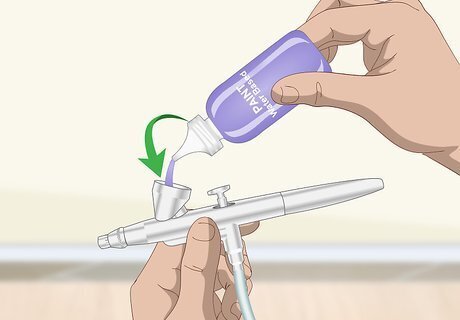
Load the paint into the airbrush cup. Most airbrush guns will have a cup-shaped hole at the top. This is where you will pour your paint to load the gun. You don’t need a lot of paint for nail art design, so 4-6 drops should be enough. If you run out, you can always add more. Some airbrush kits will come with paint that attaches to the bottom of the gun. Read the manufacturer’s instructions on how to properly load the paint.

Pull the airbrush trigger to release the paint. Now that your paint is loaded into the gun, you’re ready to start painting! Some airbrushes have a rounded trigger at the top, while others have a pointed trigger at the bottom. Whichever type you have, all you need to do is hold the handle like you would a pencil and pull the trigger back with your index finger to release the paint. If you’re using a dual-action airbrush, first release the air by pressing down on the trigger. Then pull the trigger back to release the paint. Make sure the air is coming out at all times. You can adjust the volume of paint using the trigger. The amount of pressure you put on the trigger controls how much paint is released.
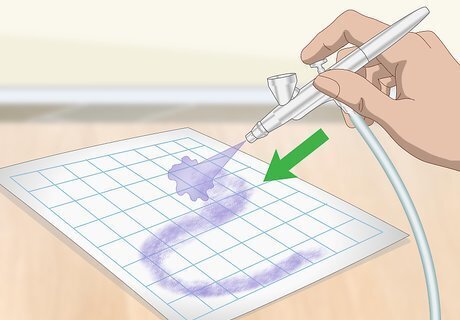
Practice using the airbrush gun on graph paper. If you’re new to nail design using an airbrush kit, it would be wise to practice operating the gun on paper before you start painting your actual nails. You can use graph paper to practice making straight lines with the airbrush gun. While you’re practicing spraying the gun, pay attention to the pressure you put on the trigger, your hand motion, and the angle of the gun. While you’re practicing on the paper, the paint should go on dry. If it’s going on wet, you’re pulling the trigger back too far. You can also practice spraying dots on the graph paper by just pressing the trigger without moving the gun. The dot should be clear and perfectly round.
Creating Designs with Stencils

Protect your workspace with newspaper or a drop cloth. Airbrushing your nails can be a messy process. To protect the area where you’ll be painting, spread out some newspaper or a cloth to catch any dripping paint. If you use a cloth, make sure to choose something you don’t mind getting messy (like an old tablecloth or sheet).
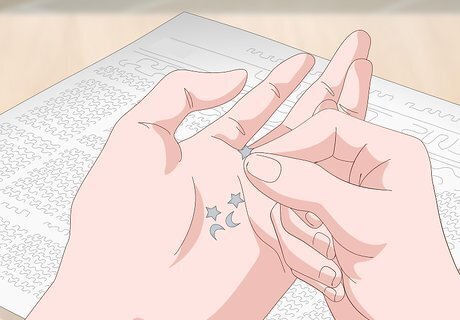
Select your preferred stencil. When airbrushing nails, the options for stencil designs are endless. You can make a design with star shapes or abstract patterns. Choose whatever best fits your personal style. You can find stencils at most local beauty supply stores. Airbrush stencils are versatile and most are reusable. You can choose between plastic, paper, and self-adhesive stencils. Purchase plastic stencils if you plan on reusing them. If you want to make your own stencils, create designs on paper with designer hole punchers or a craft knife. You can even use materials you already have at home, such as lace or feathers.
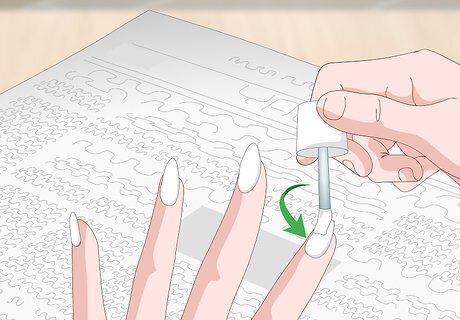
Apply a base coat to your nails. Use a base coat that is specifically for airbrush nail designs. Some airbrush paints will not adhere to regular base coat nail polish. Apply the base coat like you would regular nail polish. Use the provided brush to apply a thin coat on each nail, then let it dry. Check the supplier of your airbrush kit. They may offer specific top and base coats to use on your nails. Apply a thin layer of white nail polish over the topcoat to really make the airbrush paint pop.
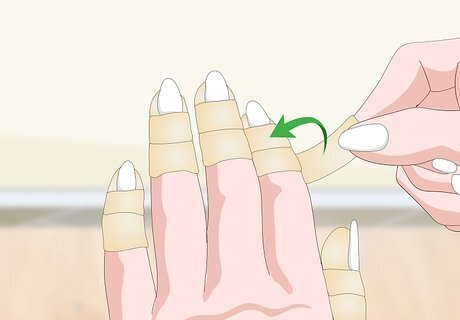
Put tape around your nails to avoid getting airbrush paint on your skin. If you’re airbrushing without stencils, or you’re using small stencils that don’t cover your fingers, you are bound to get paint on your skin. To avoid this, get some tape, tear it into small pieces, and place it around the nail. This will prevent spray paint from getting on your skin and make cleanup easy. Make sure the tape isn’t covering any part of the nail you wish to spray paint.
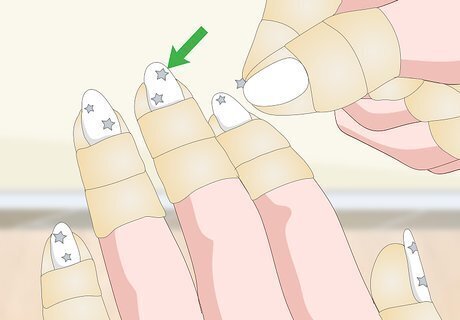
Place the stencil on top of your fingernail. When you’ve chosen a stencil, put it on top of the nail, making sure to place it in the area you want the design. Some stencils that you buy from the beauty supply store will have a sticky side, so use that to apply it to the nail and keep it in place. Make sure your base coat is completely dry before placing the stencil on the nail. You can experiment with designs by adding multiple stencil layers.

Spray the airbrush over the stencil to create the design. When your stencil is in place, you can begin painting. Aim the airbrush at a protected surface and pull the trigger on the airbrush gun to release the paint. Once you have a stream going, move the airbrush over the stencil on your fingernail. Spray lightly on the stencil until you see the holes completely covered with your paint color. That way, you know your design will come out complete. Move the airbrush gun in a smooth, fluid motion as you work to get even results. Once you’re done spraying, move the airbrush away from your nail with the stream still going before you release the trigger. Repeat this step for all the nails you want to apply a design to.
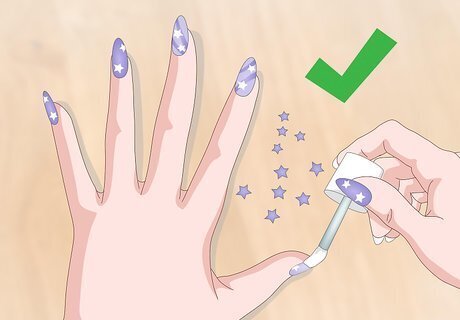
Remove the stencil and apply a topcoat to seal the nail design. Once you have finished using the airbrush to create your designs, take the stencil off of your nails. Make sure the paint is dry, and then apply a topcoat. You can purchase topcoats designed specifically for airbrushed nail art. They will seal and protect your designs and prevent chipping and fading. Make sure your base coat and airbrush paint are completely dry before applying the topcoat. Apply 2 coats for extra protection.










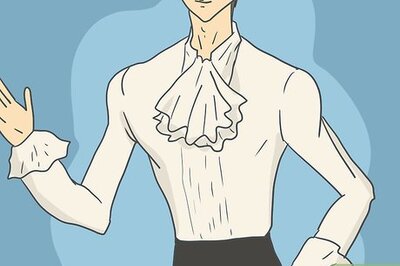









Comments
0 comment